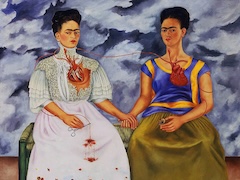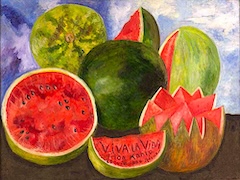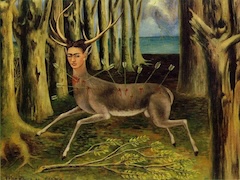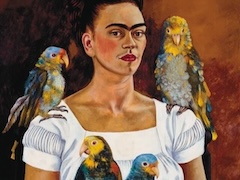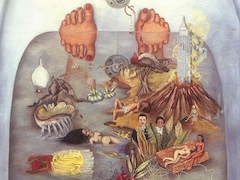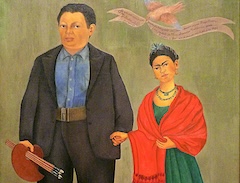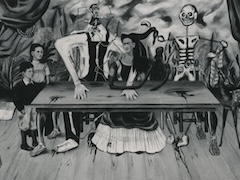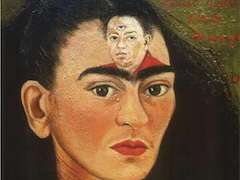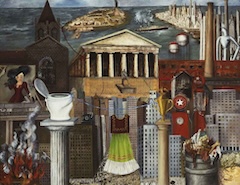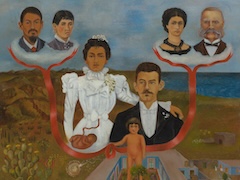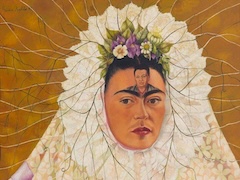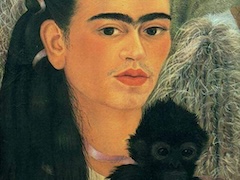Frida Kahlo biography
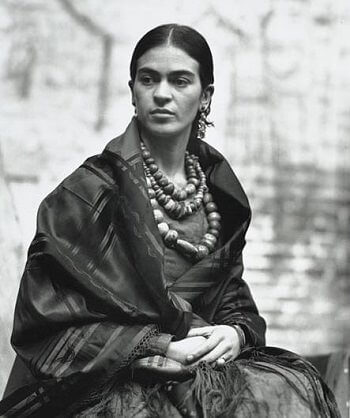
Considered one of Mexico's greatest artists, Frida Kahlo was born on July 6, 1907 in Coyocoan, Mexico City, Mexico. She grew up in the family's home where was later referred to as the Blue House or Casa Azul. Her father is a German descendant and photographer. He immigrated to Mexico where he met and married her mother Matilde. Her mother is half Amerindian and half Spanish. Frida Kahlo has two older sisters and one younger sister.
Frida Kahlo has poor health in her childhood. She contracted polio at the age of 6 and had to be bedridden for nine months. This disease caused her right leg and foot to grow much thinner than her left one. She limped after she recovered from polio. She has been wearing long skirts to cover that for the rest of her life. Her father encouraged her to do lots of sports to help her recover. She played soccer, went swimming, and even did wrestle, which is very unusual at that time for a girl. She has kept a very close relationship with her father for her whole life.
Frida Kahlo attended the renowned National Preparatory School in Mexico City in the year of 1922. There are only thirty-five female students enrolled in that school and she soon became famous for her outspokenness and bravery. At this school she first met the famous Mexican muralist Diego Rivera for the first time. Rivera at that time was working on a mural called The Creation on the school campus. Frida often watched it and she told a friend she will marry him someday.
In the same year, Kahlo joined a gang of students who shared similar political and intellectual views. She fell in love with the leader Alejandro Gomez Arias. On a September afternoon when she traveled with Gomez Arias on a bus the tragic accident happened. The bus collided with a streetcar and Frida Kahlo was seriously injured. A steel handrail impaled her through the hip. Her spine and pelvis are fractured and this accident left her in a great deal of pain, both physically and physiologically.
She was injured so badly and had to stay in the Red Cross Hospital in Mexico City for several weeks. After that, she returned home for further recovery. She had to wear full-body cast for three months. To kill the time and alleviate the pain, she started painting and finished her first self-portrait the following year. Frida Kahlo once said,
I paint myself because I am often alone and I am the subject I know best".
Her parents encouraged her to paint and made a special easel made for her so she could paint in bed. They also gave her brushes and boxes of paints.
Frida Kahlo reconnected with Rivera in 1928. She asked him to evaluate her work and he encouraged her. The two soon started the romantic relationship. Despite her mother's objection, Frida and Diego Rivera got married in the next year. During their earlier years as a married couple, Frida had to move a lot based on Diego's work. In 1930, they lived in San Francisco, California. Then they moved to New York City for Rivera's artwork show at Museum of Modern Art. They later moved to Detroit while Diego Rivera worked for Detroit Institute of Arts.
In 1932, Kahlo added more realistic and surrealistic components in her painting style. In the painting titled Henry Ford Hospital(1932), Frida Kahlo lied on a hospital bed naked and was surrounded with a few things floating around, which includes a fetus, a flower, a pelvis, a snail, all connected by veins. This painting was an expression of her feelings about her second miscarriage. It is as personal as her other self-portraits.
In 1933, Kahlo was living in New York City with her husband Diego Rivera. Rivera was commissioned by Nelson Rockefeller to create a mural named as Man at the Crossroads at Rockefeller Center. Rivera tried to include Vladimir Lenin in the painting, who is a communist leader. Rockefeller stopped his work and that part was painted over. The couple had to move back to Mexico after this incident. They returned and live in San Angel, Mexico.
Frida Kahlo and Diego Rivera's marriage is not a usual one. They had been keeping separate homes and studios for all those years. Diego had so many affairs and one of that was with Kahlo's sister Cristina. Frida Kahlo was so sad and she cut off her long hair to show her desperation to the betrayal. She has longed for children but she cannot bear one due to the bus accident. She was heartbroken when she experienced a second miscarriage in 1934. Kahlo and Rivera have been separated a few times but they always went back together. In 1937 they helped Leon Trotsky and his wife Natalia. Leon Trotsky is an exiled communist and rival of Soviet leader Joseph Stalin. Kahlo and Rivera welcomed the couple together and let them stay at her Blue House. Kahlo also had a brief affair with Leon Trotsky when the couple stayed at her house.
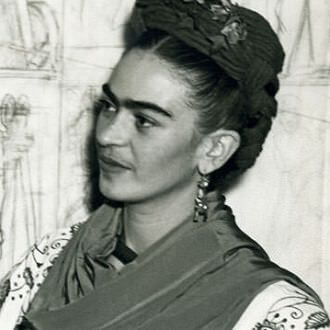
In 1938, Frida Kahlo became a friend of André Breton, who is one of the primary figures of the Surrealism movement. Frida said she never considered herself as a Surrealist "until André Breton came to Mexico and told me I was one." She also wrote, "Really I do not know whether my paintings are surrealist or not, but I do know that they are the frankest expression of myself". "Since my subjects have always been my sensations, my states of mind and the profound reactions that life has been producing in me, I have frequently objectified all this in figures of myself, which were the most sincere and real thing that I could do in order to express what I felt inside and outside of myself."
In the same year, she had an exhibition at New York City gallery. She sold some of her paintings and got two commissions. One of that is from Clare Boothe Luce to paint her friend Dorothy Hale who committed suicide. She painted The Suicide of Dorothy Hale (1939), which tells the story of Dorothy's tragic leap. The patron Luce was horrified and almost destroyed this painting.
The next year, 1939, Kahlo was invited by André Breton and went to Paris. Her works are exhibited there and she is befriended with artists such as Marc Chagall, Piet Mondrian, and Pablo Picasso. She and Rivera got divorced that year and she painted one of her most famous paintings, The Two Fridas(1939).
But soon Frida Kahlo and Diego Rivera remarried in 1940. The second marriage is about the same as the first one. They still keep separate lives and houses. Both of them had infidelities with other people during the marriage. Kahlo received a commission from the Mexican government for five portraits of important Mexican women in 1941, but she was unable to finish the project. She lost her beloved father that year and continued to suffer from chronic health problems. Despite her personal challenges, her work continued to grow in popularity and was included in numerous group shows around this time.
In the year of 1944, Frida Kahlo painted one of her most famous portraits, The Broken Column. In this painting, she depicted herself naked and split down the middle. Her spine is shattered like a column. She wears a surgical brace and there are nails all through her body, which is the indication of the consistent pain she went through. In this painting, Frida expressed her physical challenges through her art. During that time, she had a few surgeries and had to wear special corsets to protect her back spine. She seeks lots of medical treatment for her chronic pain but nothing really worked.
Her health condition has been worsening in 1950. That year she was diagnosed with gangrene in her right foot. She became bedridden for the next nine month and had to stay in hospital and had several surgeries. But with great persistence, Frida Kahlo continued to work and paint. In the year of 1953, she had a solo exhibition in Mexican. Although she had limited mobility at that time, she showed up on the exhibition's opening ceremony. She arrived by ambulance, and welcomed the attendees, celebrated the ceremony in a bed the gallery set up for her. A few months later, she had to accept another surgery. Part of her right leg got amputated to stop the gangrene.
With the poor physical condition, she is also deeply depressed. She even had an inclination for suicide. Frida Kahlo has been out and in hospital during that year. But despite her health issues, she has been active with the political movement. She showed up at the demonstration against US-backed overthrow of President Jacobo Arbenz of Guatemala on July 2. This is her last public appearance. About one week after her 47th birthday, Frida Kahlo passed away at her beloved Bule House. She was publicly reported to die of a pulmonary embolism, but there is speculation which was saying she died of a possible suicide.
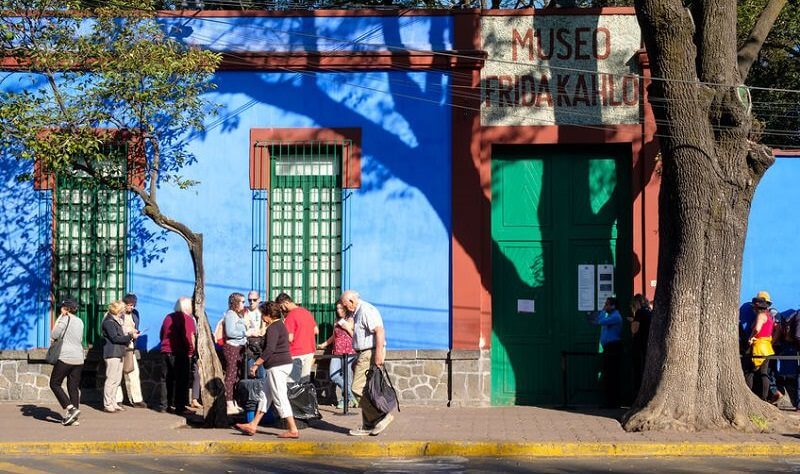
Frida Kahlo's fame has been growing after her death. Her Blue House was opened as a museum in the year of 1958. In the 1970s the interest in her work and life is renewed due to the feminist movement since she was viewed as an icon of female creativity. In 1983, Hayden Herrera published his book on her, A Biography of Frida Kahlo, which drew more attention from the public to this great artist. In the year of 2002, a movie named Frida was released, staring alma Hayek as Frida Kahlo and Alfred Molina as Diego Rivera. This movie was nominated for six Academy Awards and won for Best Makeup and Original Score.

